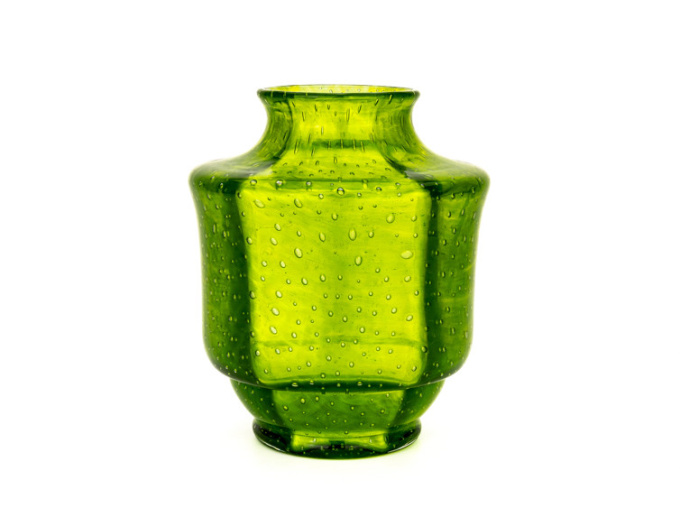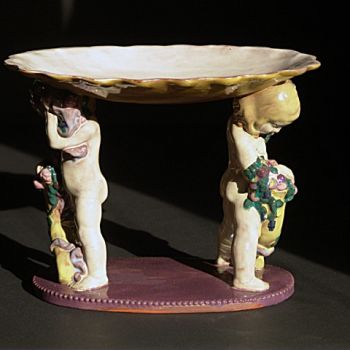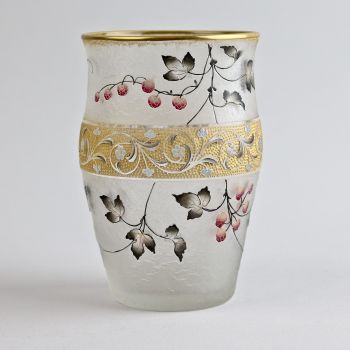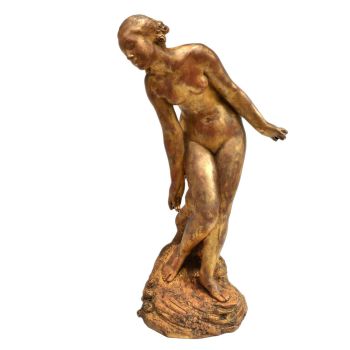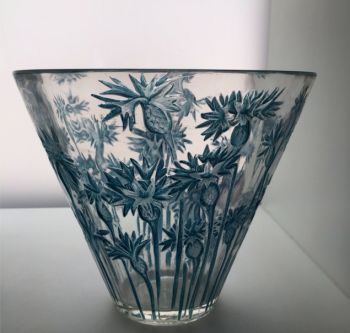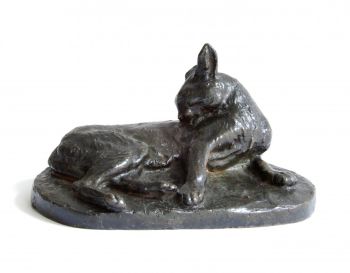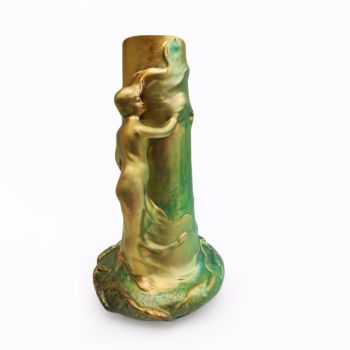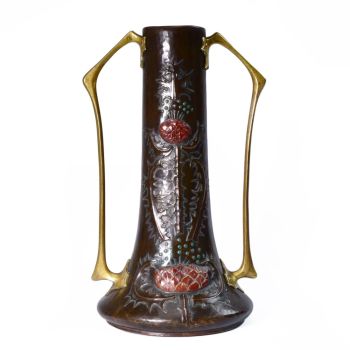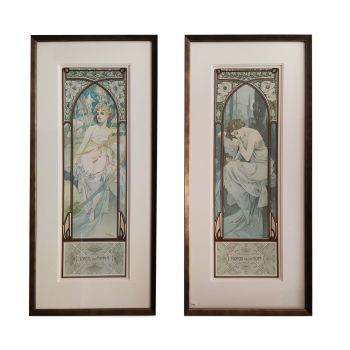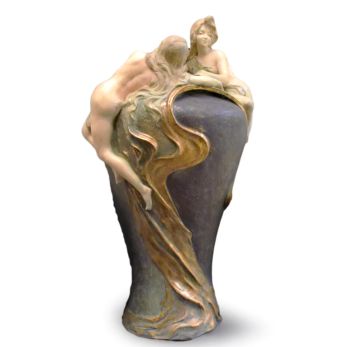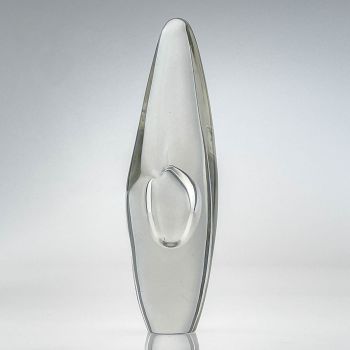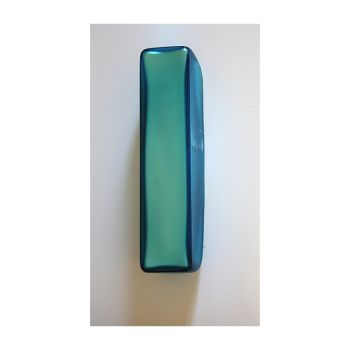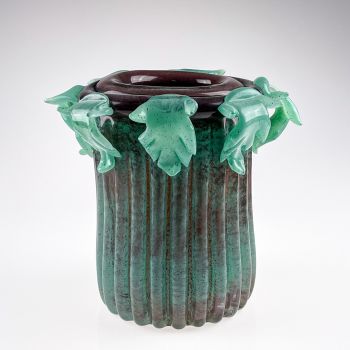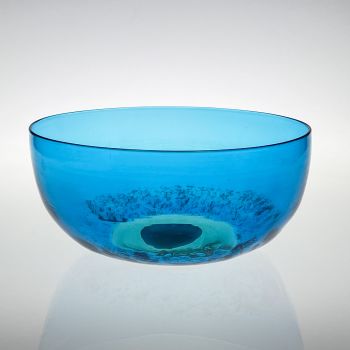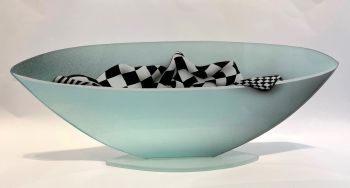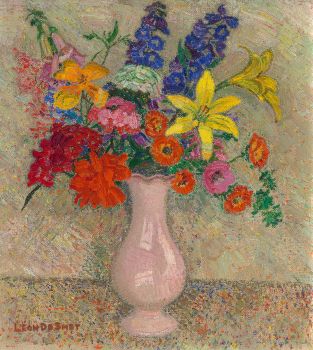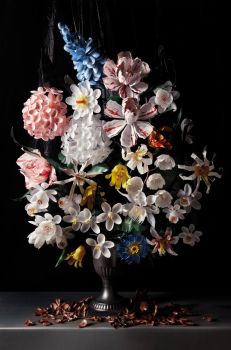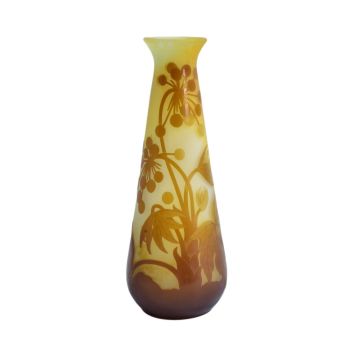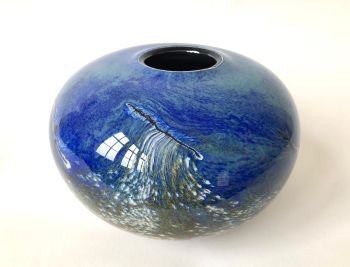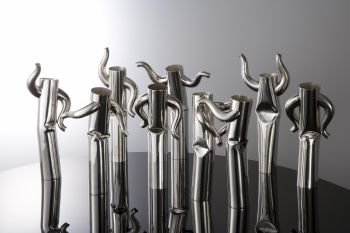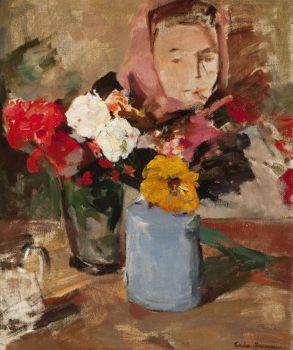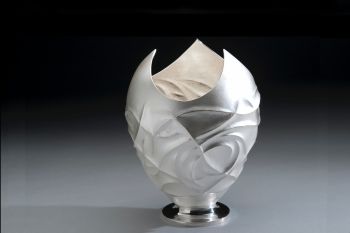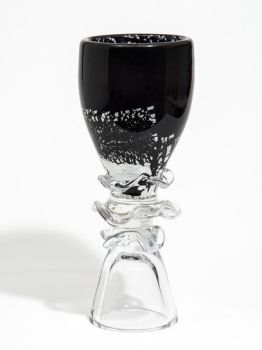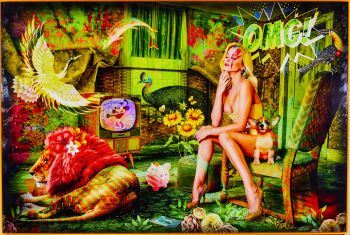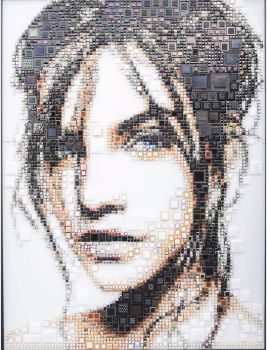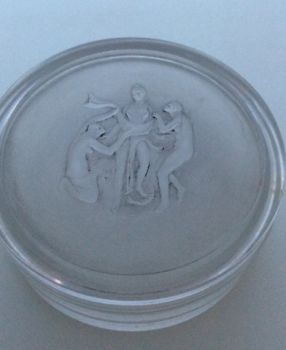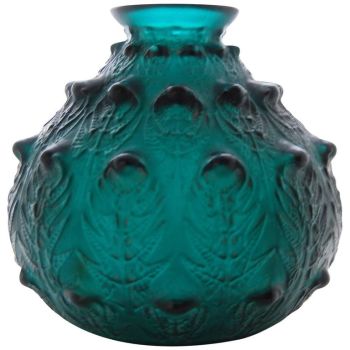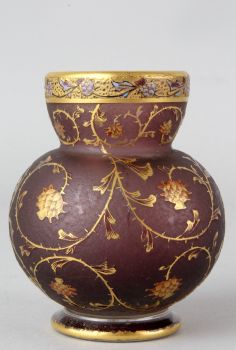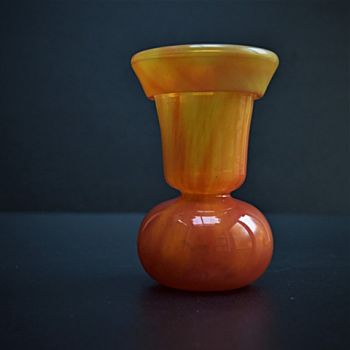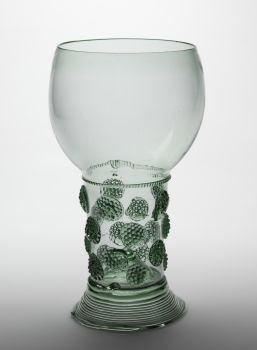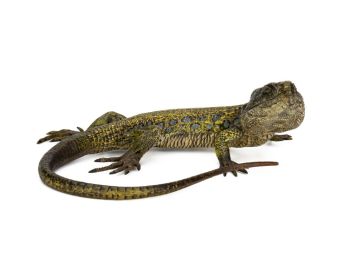Johann Loetz Witwe – Ausführung 140 – “Controlled air bubbles” in ground color Green 1900 - 1909
Johann Loetz (Lötz) Witwe Klostermühle
Bicchiere
14 cm, ø 12 cm
ConditionExcellent
Prezzo su richiesta
Antiques Emporium
- A proposito di opere d'arteThis masterpiece by Johann Loetz Witwe executed in Ausführung 140 is a true testament to the artistry and innovation of the Jugendstil era.
Adorned in a captivating ground color of verdant green, this vase exudes a sense of natural splendor that is both captivating and evocative. However, its true beauty lies in the intricate layers of glasswork that adorn its surface, each telling a story of craftsmanship and creativity.
At its core, the vase boasts an inner layer of titania glass threads, delicately woven to create a mesmerizing interplay of light and texture. These threads dance within the glass, casting enchanting shadows and lending an ethereal quality to the piece. Surrounding them is a layer of controlled air bubbles, suspended in a delicate dance that adds depth and intrigue to the vase’s design.
Finally, the outer layer of green glass encases this symphony of elements, providing a glossy finish that enhances the vase’s luminous presence. With each glance, new details emerge, inviting admiration and appreciation for the skill and artistry required to create such a masterpiece.
It’s important to note that while the accompanying pictures offer a glimpse into the vase’s beauty, they cannot fully capture the breathtaking colors and textures of the glass. The subtle nuances and iridescence of the glass can only be fully appreciated in person, adding to the allure and mystique of this remarkable piece.
Dimensions:
Height: 145mm / 5.71”
Diameter top: 65mm / 2.56”
Diameter body: 120mm / 4.72″
Literature:
Prestel – Böhmisch Glas 1880 – 1940 Band 1 Werkmonographie – Page 269. - A proposito di opere artista
La vetreria Loetz esisteva a Klostermuhle, in Austria, da poco più di cento anni, a partire dal 1840. Ma il suo periodo di massimo splendore fu durante la vita di Max Ritter Von Spaun, nipote dell'originale Johann Loetz che aveva fondato l'azienda.
Von Spaun rilevò l'azienda nel 1879 e la diresse fino al 1908, un anno prima della sua morte. Fu assistito da Eduard Prochaska, suo tecnico specialista, e insieme inventarono, progettarono e produssero tutta una serie di meravigliosi nuovi tipi di vetro, ottenendo numerosi brevetti e vincendo premi in tutte le maggiori esposizioni mondiali durante gli anni 1890 e i primi anni del il nuovo secolo.
L'azienda Loetz era tra i leader nel design Art Nouveau e in particolare nel vetro artistico iridescente. Il vetro "Papillon", come il vaso a sinistra, è talvolta noto oggi come vetro "macchia d'olio". Un'altra colorazione preferita di Loetz era il vetro irridizzato con scie tirate chiamato vetro "Fenomeno".
C'erano vasi irrigiati con nastri di colori metallici che si snodavano sulla superficie, e molti disegni spettacolari con scie applicate di bellissimi colori, o semplicemente tirati fuori dal corpo del vetro per formare maniglie o decorazioni.
Intorno al 1900 l'azienda iniziò a collaborare con designer esterni e alcuni grandi artisti disegnarono pezzi per Lotz, in particolare Joseph Hofmann, Koloman Moser, Maria Kirchner e Hofstatter.
Nel 1908 Loetz fu rilevata dal figlio di Max Von Spaun, anche lui chiamato Max, e sebbene stentasse finanziariamente (fallendo nel 1911 e di nuovo nel 1931) ci furono diversi grandi designer il cui lavoro fu prodotto da Loetz in quegli anni e attraverso l'arte periodo déco. Questi includevano Adolf Beckert e Michael Powolny.
Sei interessato ad acquistare questa opera d'arte?
Artwork details
Related artworks
Johann Loetz (Lötz) Witwe Klostermühle
Johann Loetz Witwe – Jugendstil Cobalt Papillon vaas1900 - 1910
Prezzo su richiestaAntiques Emporium
Johann Loetz (Lötz) Witwe Klostermühle
Johann Loetz Witwe – Phänomen Genre vaas in blauw opaal – 19021902 - 1903
Prezzo su richiestaAntiques Emporium
Johann Loetz (Lötz) Witwe Klostermühle
Johann Loetz Witwe - Phänomen Genre 7773 – Orange1900 - 1910
Prezzo su richiestaAntiques Emporium
Johann Loetz (Lötz) Witwe Klostermühle
Johann Loetz Witwe - Flamarion Titania bowl – Franz Hofstätter1900 - 1910
Prezzo su richiestaAntiques Emporium
1 - 4 / 7Johann Loetz (Lötz) Witwe Klostermühle
Johann Loetz Witwe – Jugendstil Cobalt Papillon vaas1900 - 1910
Prezzo su richiestaAntiques Emporium
René Lalique
Uno dei primi vasi "Bluets" disegnato da Rene Lalique (1860-1945)1910 - 1920
Prezzo su richiestaLennart Booij Fine Art and Rare Items
Johann Loetz (Lötz) Witwe Klostermühle
Johann Loetz Witwe - Flamarion Titania bowl – Franz Hofstätter1900 - 1910
Prezzo su richiestaAntiques Emporium
1 - 4 / 24- 1 - 4 / 24
Johann Loetz (Lötz) Witwe Klostermühle
Johann Loetz Witwe - Phänomen Genre 7773 – Orange1900 - 1910
Prezzo su richiestaAntiques Emporium
Coba Ritsema
Two vases with flowers and a portrait1900 - 1950
Prezzo su richiestaKunsthandel Pygmalion
1 - 4 / 24Artista Sconosciuto
Verre à boire Cristallo façon de Venise1600 - 1650
Prezzo su richiestaPeter Korf de Gidts - Antiquairs
René Lalique
Una rara scatola per Nina Ricci circa 19371937
Prezzo su richiestaLennart Booij Fine Art and Rare Items
René Lalique
Un rarissimo vaso "Fougeres" verde intenso disegnato da R. Lalique1912
€ 8.950Lennart Booij Fine Art and Rare Items
 A cura di
A cura diSilla Scheepens
Johann Loetz (Lötz) Witwe Klostermühle
Johann Loetz Witwe - Phänomen Genre 7773 – Orange1900 - 1910
Prezzo su richiestaAntiques Emporium
1 - 4 / 24Johann Loetz (Lötz) Witwe Klostermühle
Johann Loetz Witwe – Phänomen Genre vaas in blauw opaal – 19021902 - 1903
Prezzo su richiestaAntiques Emporium
Amalric Walter
Amalric Walter & Henri Bergé – Crabe plumier1920 - 1929
Prezzo su richiestaAntiques Emporium
Johann Loetz (Lötz) Witwe Klostermühle
Johann Loetz Witwe – Jugendstil Cobalt Papillon vaas1900 - 1910
Prezzo su richiestaAntiques Emporium
Frères Daum
Daum Nancy – “Paysage Soleil Couchant” vase with two applied handles1900 - 1910
Prezzo su richiestaAntiques Emporium
Johann Loetz (Lötz) Witwe Klostermühle
Johann Loetz Witwe - Flamarion Titania bowl – Franz Hofstätter1900 - 1910
Prezzo su richiestaAntiques Emporium
Gabriel Argy-Rousseau
Gabriël Argy-Rousseau – Crabes et Algues vase – 19201920 - 1929
Prezzo su richiestaAntiques Emporium
Franz (NamGreb) Bergmann
Franz Bergman – Viennese cold-painted bronze lizard with a mechanical mouth1900 - 1909
Prezzo su richiestaAntiques Emporium
1 - 4 / 12

